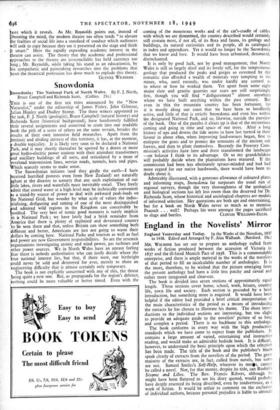Snowdonia
)5nowdonla: The National l'ark of North Wales. By F. J. North, Bruce Campbell and Richenda Scott. (Collins. 2ls.)
tI'ttts is one of the first ten titles announced by the "New aturalist," under the editorship of James Fisher, John Gilmour, Julian Huxley and Dudley Stamp. The three writers appointed to he task, F. J. North (geologist), Bruce Campbell (natural history) and Richenda Scott (historical background), have handsomely fulfilled
eir several assignments and contrived to cram into one readable ok the pith of a score of others on the same terrain, besides the results of their own intensive field researches. Apart from the trinsic and abiding interest of this territory, it has, at the moment,
f. double topicality. It is likely very soon to be declared a National ark, and it may shortly thereafter be spotted by a dozen or more trent hydro-electric power stations with their attendant transformers nd ancillary buildings of all sorts, and reticulated by a maze of verhcad transmission lines, service roads, tunnels, leets and pipes. Which scarcely seems to make sense.
The Snowdonian initiates (and they girdle the earth—I hasie eceived horrified protests even from New Zealand) are naturally ghast at the disaster to scenery that any such exploitation of our 'Ede lakes, rivers and waterfalls must inevitably entail. They freely dmit that stored water at a high level may be technically convenient s a stand-by source of power to deal with awkward peak-loads on e National Grid, but wonder by what scale of values the indus- ialising, disfiguring and taming of one of the most distinguished
. nd admired wild regions in the Kingdom can conceivably be ustified. The very best of scenic good manners is surely implicit an a National Park ; we have lately had a brisk reminder from 'America that there is plenty of exploited and devastated country 'to be seen there and that, unless Britain can show something both different and better, Americans are just not going to waste their dollars by coming here. National Parks and tourism as well as fuel ind power are now Government responsibilities. So are the research 'Organisations investigating atomic and wind power, gas turbines and other power sources. We in North Wales have an uneasy feeling
at there is nobody authoritative who can justly decide where the true national interest lies, but that, if there were, our birthright could never be sold and destroyed for ever, merely to abate an engineering difficulty that is almost certainly only temporary.
The book is not explicitly concerned with any of this, the threat being quite a new one. But, as propaganda for the region's defence, 'nothing could be more valuable or better timed. Even with the
i
coming of the monstrous works and of the cat's-cradle of cables with which we are threatened, the country described would certainly still contain most, if not all, of its flora and fauna, its geology and buildings, its natural curiosities and its people, all as catalogued in index and appendices. Yet it would no longer be the Snowdonia that we know and love. It would have been urbanised, denatured, disenchanted.
It is only by good luck, not by good management, that North Wales is still so largely aloof and its lovely self, for the tempestuous geology that produced the peaks and gorges so esteemed by the romantic also afforded a wealth of minerals very tempting to the miner, who, until recently, was under hardly any control as to where or how he worked them. Yet apart from some eight major slate and granite quarries our scars are still surprisingly few, though you will find " disfigurement " almost anywhere where we have built anything within the past century. But even in this the mountain country has been fortunate, for it is mostly along our coast that we have been so heedlessly active, and little of that is strictly Snowdonia and even less within the designated National Park, and so, likewise, outside the purview of the book. One of the puzzles it clears up is that of the mysterious corning and going in time and space or our trees. After a long history of ups and downs the tide seems to have last turned in their favour in about 1800, when improving land-owners began, first to extirpate the goats and to protect the remnants of the ancient oak forests, and then to plant themselves. Recently the Forestry Com- mission's activities have here and there transformed the landscape —on balance I think to its advantage. Or so my grandchildren will probably decide when the plantations have matured. If the commission had been less obstinately spruce-minded and had had more regard for our native hardwoods, there would have been no doubt about it.
Admirably illustrated, with a generous allowance of coloured plates and informing maps, Snowdonia far surpasses the usual run of regional surveys, though the very thoroughness of the geological and biological sections has left less room than she deserved for Dr. Richenda Scott, whose historical and sociological chapters are models of informed selection. Her quotations are both apt and entertaining, but for a book on North Wales never so much as to mention Peacock . . . well! Perhaps his were amongst the pages sacrificed
to slugs and beetles. CLOUGH WILLIAMS-ELLIS.














































































 Previous page
Previous page